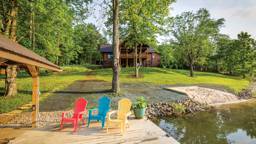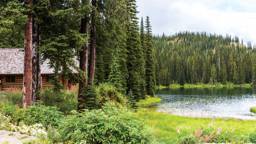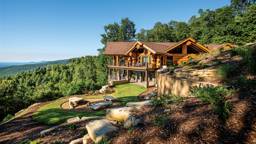
If you use your cabin as a second home, bring aspects of your pet’s special area — such as gravel — to the cabin to help it acclimate. Photo courtesy of greenscenelandscape.com

Special pathways will prevent worn areas in your yard and give your dog a place it feels it can roam. Photo courtesy of greenscenelandscape.com/Mike Kaufman
Positive Reinforcement
One of the biggest mistakes owners make, Doherty notes, is treating the back yard as a punishment area or just a place where their pets relieve themselves. Lack of design considerations restricts the opportunities dogs have to enjoy the yard. More active dogs may benefit from an exercise course, which can be a simple set of polyvinyl chloride (PVC) structures, while others may be satisfied with a little side yard to call their own or a game of hide-and-seek with treats. To make dog-friendly landscaping successful, however, you need to train your dog on how to use its features:
The rural environment of a cabin can present its own set of challenges. A fence of some sort is important to not only keep your dog from getting lost in the woods; it also protects your pet from run-ins with less-sociable wild animals. Make sure the partitions of the fence are placed close together, or use a solid wall to prevent your dog from being able to stick out its nose.
 Predatory animals, such as coyotes, pose an obvious threat to your pet, but others present additional dangers that you need to be wary of as well:
Predatory animals, such as coyotes, pose an obvious threat to your pet, but others present additional dangers that you need to be wary of as well:
Thick-coated breeds such as Great Pyrenees and Newfoundlands are naturally heat sensitive and require shade, but all dogs can benefit from some form of shelter — whether it’s a doghouse or just a crate — in the case of inclement weather. “The weather and the elements can be very different at a cabin,” Doherty notes. “You may not realize just how sunny it gets or how snowy it gets, and [your pets] need a safe place to retreat. That way, if they want to take cover, they can.”
One of the biggest mistakes owners make, Doherty notes, is treating the back yard as a punishment area or just a place where their pets relieve themselves. Lack of design considerations restricts the opportunities dogs have to enjoy the yard. More active dogs may benefit from an exercise course, which can be a simple set of polyvinyl chloride (PVC) structures, while others may be satisfied with a little side yard to call their own or a game of hide-and-seek with treats. To make dog-friendly landscaping successful, however, you need to train your dog on how to use its features:
- Correct them for misuse of the yard while simultaneously praising them for using the correct spot.
- Send a clear message to prevent confusion (e.g., keep your dog away from you as you’re gardening if you don’t want to end up with uprooted plants).
The rural environment of a cabin can present its own set of challenges. A fence of some sort is important to not only keep your dog from getting lost in the woods; it also protects your pet from run-ins with less-sociable wild animals. Make sure the partitions of the fence are placed close together, or use a solid wall to prevent your dog from being able to stick out its nose.

Ample water, whether from a regularly refilled water bowl or a dedicated freshwater source, is essential. Photo courtesy of greenscenelandscape.com/Mary Barnhill
- Maintain dog-friendly landscaping through pruning and regular mowing to keep rodents carrying ticks and fleas from entering the yard to snack on the underbrush of your plantings.
- Regular lawn maintenance also can deter snails from populating your yard. Poisons used to rid your yard of these gastropods can be incredibly harmful to dogs — both in the accidental ingestion of the product and the tainted snail itself.
Thick-coated breeds such as Great Pyrenees and Newfoundlands are naturally heat sensitive and require shade, but all dogs can benefit from some form of shelter — whether it’s a doghouse or just a crate — in the case of inclement weather. “The weather and the elements can be very different at a cabin,” Doherty notes. “You may not realize just how sunny it gets or how snowy it gets, and [your pets] need a safe place to retreat. That way, if they want to take cover, they can.”











